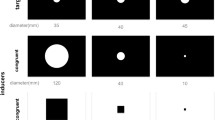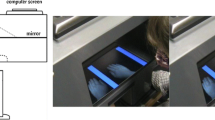Abstract
According to current concepts, the execution of expedient actions well-coordinated in space becomes possible owing to the creation of a system for internal representation, which includes a body coordinate system, in the central nervous system. The goal of this study was to assess the effects induced by the exclusion of vision and a left-right inversion in visual space on the accuracy in the internal representation of hands and on aimed arm movements. The study cohort included 16 participants aged from 18 to 25 years. The experiment consisted of two test series. In the first series, a subject placed his/her left hand under a transparent plexiglass screen. Upon the experimenter’s command, the subject had to indicate the position of his/her left wrist and the terminal phalanges of the thumb, middle and little fingers with his/her right index finger on the plexiglass, which was accompanied by the corresponding marks displayed on the screen. The positional accuracy in the subject’s perception of his/her own hand position was recorded in the conditions of a leftright inversion of visual space, which were created by wearing prismatic spectacles and the exclusion of visual control. In the second case, the subject’s left hand was replaced on the table under the transparent screen by a similarly shaped left hand belonging to another person. It has been shown that the positions of the middle fingertip and the wrist were sufficiently precisely perceived by the subject through prismatic spectacles. However, the position of the tips of the thumb and little finger relative to the axis connecting the wrist and the terminal phalanx of the middle finger (the hand axis) was perceptually inverted. The accuracy of the indication was reduced for all fingers when the eyes were closed. In testing another person’s hand, a left–right inversion in the visual space created an illusory 90° turn of the hand’s axis and an illusory bias relative to the wrist towards elongation in the marker points corresponding to another person’s fingers. We can suggest that when the alien hand replaced the subject’s own hand, in accordance with the modulations in the motor task conditions, the egocentric system of coordinates was replaced by the allocentric system. The role of vision in the execution of spatially oriented and accurate hand movements increased in this case.
Similar content being viewed by others
References
Holmes, N.P. and Spence, C., The body schema and the multisensory representation(s) of peripersonal space, Cognit. Process., 2004, vol. 5, no. 2, p. 94.
Volcic, R., Maarten, W.A., Wijntjes, E.C., et al., Crossmodal visuo-haptic mental rotation: comparing objects between senses, Exp. Brain Res., 2010, vol. 203, no. 3, p. 621.
Kuling, I.A., van der Graaff, M.C.W., Brenner, E., and Smeets, J.B.J., Matching locations is not just matching sensory representations, Exp. Brain Res., 2017, vol. 235, no. 2, p. 533.
van Beers, R.J., Wolpert, D.M., and Haggard, P., When feeling is more important than seeing in sensorimotor adaptation, Curr. Biol., 2002, vol. 12, p. 834.
Volcic, R. and Kappers, A.M.L., Allocentric and egocentric reference frames in the processing of threedimensional haptic space, Exp. Brain Res., 2008, vol. 188, no. 2, p. 199.
Kireeva, T.B., Levik, Yu.S., and Holmogorova, N.V., Interaction of visual and proprioceptive information in the perception of the position of the hand, Ross. Zh. Biomekh., 2005, vol. 9, no. 2, p. 74.
Perera, A.T., Newport, R., and McKenzie, K.J., Changing hands: persistent alterations to body image following brief exposure to multisensory distortions, Exp. Brain Res., 2017, vol. 235, no. 6, p. 1809.
Preston, C. and Newport, R., How long is your arm? A using multisensory illusions to modify body image from the third person perspective, Perception, 2012, vol. 41, no. 2, p. 247.
Perera, A.T., Newport, R., and McKenzie, K.J., Changing hands: persistent alterations to body image following brief exposure to multisensory distortions, Exp. Brain Res., 2017, vol. 235, no. 6, p. 1809.
Bobrova, E.V., Lyakhovetskii, V.A., and Bogacheva, I.N., Learning and reproduction of memorized sequences of right and left hand, Mov. Neurosci. Behav. Physiol., 2016, vol. 46, no. 7, p. 762.
van der Kamp, J., de Wit, M.M., and Masters, R.S.W., Left, right, left, right, eyes to the front! Müller-Lyer bias in grasping is not a function of hand used, hand preferred or visual hemifield, but foveation does matter, Exp. Brain Res., 2012, vol. 218, no. 1, p. 91.
Bragina, N.N. and Dobrokhotova, T.A., Funktsional’nye asimmetrii cheloveka (Functional Asymmetry of a Man), Moscow: Meditsina, 1988.
Gurfinkel’, V.S. and Levik, Yu.S., Body concept and motor control, in Intellektual’nye protsessy i ikh modelirovanie. Orgnaizatsiya dvizhenii (Intellectual Processes and Their Modeling. Movement Organization), Chernavskii, A.V., Ed., Moscow: Nauka, 1991, p. 59.
Gurfinkel’, V.S., Debreva, E.E., and Levik, Yu.S., The role of the internal model in position perception and movement planning, Fiziol. Chel., 1986, vol. 12, p. 769.
Longo, M.R. and Haggard, P., An implicit body representation underlying human position sense, Proc. Natl. Acad. Sci. U.S.A., 2010, vol. 107, no. 26, p. 11727.
van Beers, R.J., Sittig, A.C., and Denier van der Gon, J.J., The precision of proprioceptive position sense, Exp. Brain Res., 1998, vol. 122, no. 4, p. 367.
Ramachandran, V.S., Rogers-Ramachandran, D., and Cobb, S., Touching the phantom limb, Nature, 2002, vol. 377, no. 6549, p. 489.
Longo, M.R. and Haggard, P., Implicit body representations and the conscious body image, Acta Psychol., 2012, vol. 141, no. 2, p. 164.
Lestienne, F. and Gurfinkel, V., Postural control in weightlessness: a dual process underlying adaptation to an unusual environment, Trends Neurosci., 1988, vol. 11, no. 8, p. 359.
Author information
Authors and Affiliations
Corresponding author
Additional information
Original Russian Text © N.V. Holmogorova, Yu.S. Levik, 2018, published in Fiziologiya Cheloveka, 2018, Vol. 44, No. 3, pp. 74–81.
Rights and permissions
About this article
Cite this article
Holmogorova, N.V., Levik, Y.S. Effects of Modulations of the Visual Conditions on Subjects’ Perception of Their Own and Another Person’s Hand. Hum Physiol 44, 300–306 (2018). https://doi.org/10.1134/S0362119718030076
Received:
Published:
Issue Date:
DOI: https://doi.org/10.1134/S0362119718030076




